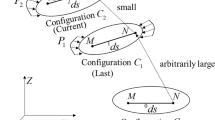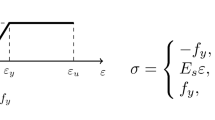Summary
The objective of current development is to give additional capabilities to the currently used MASS-SPRING/LINEAR BEAM based analysis methodology (KRASH). By adding nonlinear frame elements specialized for crash analysis, the effort of creating new models is expected to be reduced. Presently, a complex frame structure would be modeled by a series of discrete nonlinear springs without modeling the structural details, whose properties are specified mainly using experimental data. The element under development will allow us to model the frame structure in detail without increase of computational cost, and will reduce the modeling effort.
The development started with a geometrically nonlinear curved space frame kinematics and a mixed variational principle (e.g., Iura and Atluri (1988)). The variational principle allows us to have the stress and moment resultants, displacements, rotation, stretch, change in the curvature of frame, as independent variables and their relationships are written in weak form.1 Hence, the relationships between the above variables do not have to be explicitly written. This feature is particularly advantageous in modeling curved space frames whose kinematic equations are very complex.
The steps in the element construction are as follows. First, the relation between the stress/moment resultants and the change in curvature and stretch (constitutive equation) is explicitly written in the strong form. The other relations the curvature/stretch and displacement/rotation (compatibility conditions) and the equilibrium conditions are written in the weak form, satisfied in an averaged manner (i.e., for the frame as whole). Furthermore, structural collapse (characterized by a highly localized deformation zone) can be accounted for through those relationships.
Though the equations obtained through the above procedure seem complex, by the aid of a symbolic mathematics system (MATHEMATICA), the need for numerical integration is eliminated. Furthermore, as demonstrated in the example problems, the point displacement and rotation of a space curved frame which is a quarter of a ring, can be obtained within 3% accuracy and the exact solution to a cantilever beam is obtained. In this presentation, the status of such advanced curved space elements will be described.
Access this chapter
Tax calculation will be finalised at checkout
Purchases are for personal use only
Preview
Unable to display preview. Download preview PDF.
Similar content being viewed by others
References
Iura, M. and Atluri, S.N. (1989): On a consistent theory, variational formulation of finitely stretched and rotated 3-D space curved beams, Computational Mechanics 4, 73–88
Pietraskiewicz, W. and Badur, J. (1983): Finite Rotations in the Description of Continuum Deformation, Int. J. Eng. Sci. 21, 1097–1115
Atluri, S. N. (1984): Alternate Stress and Conjugate Strain Measures, and Mixed Variational Formulations Involving Rigid Rotations, for Computational Analysis of Finitely Deformed Solids, with Applications to Plates and Shells-1, Theory, Computers & Structures 18, No. 1, 93–116
Shi, G. and Atluri, S.N. (1988): Elasto-Plastic Large Deformation Analysis of Space-Frames: A Plastic Hinge and Stress-Based Explicit Derivation of Tangent Stiffness, International Journal for Numerical Methods in Engineering 26, 589–615
Gamom, M.A., Wittlin, G. and Labarge, B.L. (1986): KRASH 85 User’s Guide.
Author information
Authors and Affiliations
Editor information
Editors and Affiliations
Rights and permissions
Copyright information
© 1995 Springer-Verlag Berlin Heidelberg
About this paper
Cite this paper
Vasudevan, S., Okada, H., Atluri, S.N. (1995). Development of New Frame Finite Elements for Aircraft Crash Analysis. In: Atluri, S.N., Yagawa, G., Cruse, T. (eds) Computational Mechanics ’95. Springer, Berlin, Heidelberg. https://doi.org/10.1007/978-3-642-79654-8_364
Download citation
DOI: https://doi.org/10.1007/978-3-642-79654-8_364
Publisher Name: Springer, Berlin, Heidelberg
Print ISBN: 978-3-642-79656-2
Online ISBN: 978-3-642-79654-8
eBook Packages: Springer Book Archive




